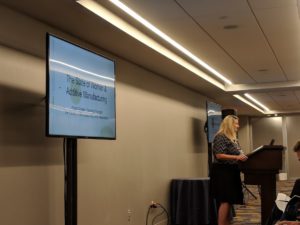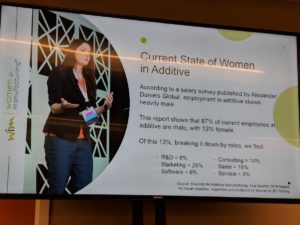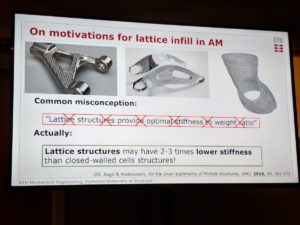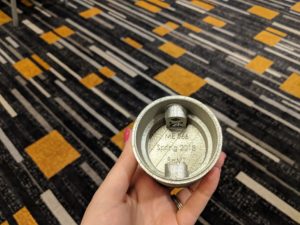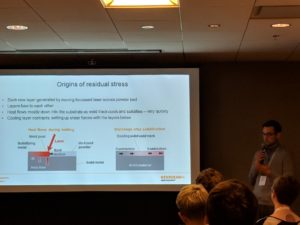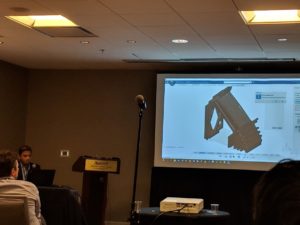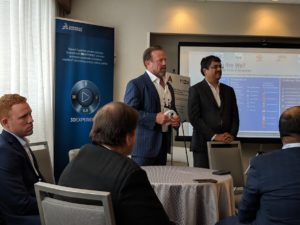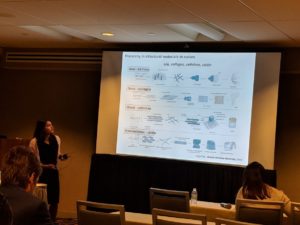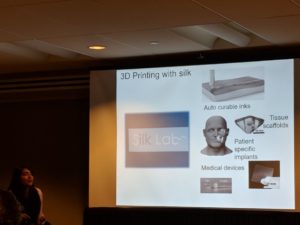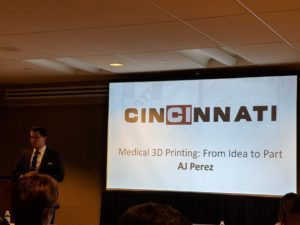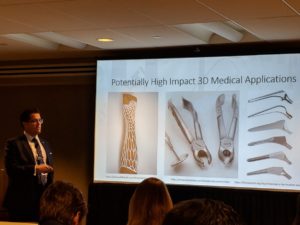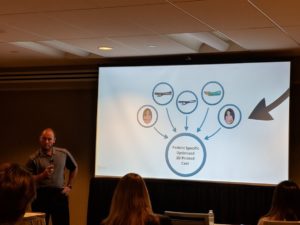Science in the Age of Experience: Additive Manufacturing Symposium Draws Expert Discussion on Progress, Challenges
 This week in Boston, Dassault Systèmes is hosting its popular Science in the Age of Experience event, which opened Monday with a full-day Additive Manufacturing Symposium (as well as symposia dedicated to materials modeling and simulatio data science). As was the case at last year’s event, the Additive Manufacturing Symposium brought together a well-curated agenda of experts to examine the progress and challenges of the 3D printing industry.
This week in Boston, Dassault Systèmes is hosting its popular Science in the Age of Experience event, which opened Monday with a full-day Additive Manufacturing Symposium (as well as symposia dedicated to materials modeling and simulatio data science). As was the case at last year’s event, the Additive Manufacturing Symposium brought together a well-curated agenda of experts to examine the progress and challenges of the 3D printing industry.
The morning plenary session began with a discussion of workforce development, as Allison Grealis, Founding President of Women in Manufacturing, shared a presentation entitled “The State of Women & Additive Manufacturing.” With a strong background in manufacturing, Grealis admitted as well that additive is not her area of expertise, but she recognizes the strong growth in this area. New opportunities, she said, need discussion of the workforce. She cited several familiar statistics: women comprise 49% of the US labor force, but just 29% of the manufacturing workforce. While that is a rise from a recent 27%, it is still a notable minority — and one only showing more disparity higher on the ladder with underrepresentation in C-suite positions, she said, citing facts and figures from McKinsey and Alexander Daniels Global.
“Opportunities for women in additive are endless,” she said. “Positions that we’ll see in 10 years don’t even exist yet. There’s a new pipeline of talent coming through that can be the right solution for the careers of the future. Organizations are becoming more aware of the importance of diversity. Top performing companies have not only a diverse hourly and management workforce, but a diverse board of directors and leadership.”
I sat down with Grealis later in the day for a longer discussion of the shape of the workforce and the importance of diversity to corporate success; our full interview can be found here.
 Ole Sigmund of the Technical University of Denmark (DTU) spoke next, sharing insights in “Topology Optimization of Structures and Infill for Additive Manufacturing.” Sigmund has been part of a team working on advanced infill structures, work we have been following as they have taken inspiration from bone to create an advanced infill methodology. He traced the origins of the approach to a 1988 study on homogenization by Bendsøe and Kikuchi, tracing up through more recent innovations at DTU with the TopOpt group.
Ole Sigmund of the Technical University of Denmark (DTU) spoke next, sharing insights in “Topology Optimization of Structures and Infill for Additive Manufacturing.” Sigmund has been part of a team working on advanced infill structures, work we have been following as they have taken inspiration from bone to create an advanced infill methodology. He traced the origins of the approach to a 1988 study on homogenization by Bendsøe and Kikuchi, tracing up through more recent innovations at DTU with the TopOpt group.
“There is a common misconception that lattice structures provide the optimal stiffness to weight ratio,” Sigmund explained. “Actually, lattice structures may have two to three times lower stiffness than closed-wall cell structures.”
Sharing examples in TopOpt formulations for coating and infill, an examination of stiffness and buckling where designs were optimized for microstructural stability, and topology optimization for thermal problems (“Heat trees are not optimal! Lamella structures are!” he noted, citing a 2018 study written by Yan, Wang, Sigmund).
From here, Dassault Systèmes shared an update into its 3DEXPERIENCE Marketplace, which launched earlier this year at SOLIDWORKS World. Pierre-Edouard Planche, Strategy and Business Development Manager, Dassault Systèmes, discussed recent introductions to the Marketplace with Make for on-demand manufacturing and PartSupply for intelligent part sourcing.
These new offerings target four customer processes, Planche shared, including:
- Upstream thinking: prototyping
- Design & Engineering: process qualification, industrialization, pre-series
- Manufacturing: manufacturing supply chain
- Ownership: spare parts / custom parts
Following the plenary session, breakout tracks dived into different aspects of additive manufacturing, with speakers presenting on Design, Manufacturing, Material, and 3D Printing in the Clinic in the morning.
- Metal part in the Manufacturing track of Dassault Systemes’ 2018 Science in the Age of Experience event [Image: Sarah Goehrke for 3DPrint.com]
In the manufacturing track, Victor Oancea, Technology Director at CTO Office R&D SIMULIA shared a look into predicting distortions, stresses, phase transformations, and mechanical properties in additive manufacturing, including a dive into melt pools, defects, volume fractions, microstructure, and mechanical properties. Case studies painted a clearer picture in the melt pool discussion, with a representative modeling setup example to look into melt pool dimensions in a parametric study.
Akshay Narasimhan of Dassault Systèmes, John Laureto from Renishaw, and Blake Porter from Stratasys shared a look next into the ways in which they work together with simulation. Laureto discussed the problem inherent in residual stress, including a look into materials most prone to residual stress and how to minimize this happening. When Renishaw looked into the materials most prone to distortion in a comparative measurement study, they found that Inconel showed the highest deflection and aluminum the lowest, wtih titanium in the middle. Narasimhan, looking at the results of the study, noted the use of simulation and geometry in accurately mapping these aspects. Porter touched on simulation as seen from the FDM side, noting that customers had expressed “enormous simulation troubles for FDM” when working with Ultem, PEKK, and other engineering-grade materials. Narasimhan noted that polymer modeling was a similar methodology for simulation, with a customized interface for the FDM 3D printing process.
During the mid-afternoon lunch break, it was a pleasure to hear from Rize and its newest partner, Azoth, in a press conference delving into the announcement made that day for indirect supply chain. Rize CEO and President Andy Kalambi and Scott Burk, Co-President of Azoth parent company PSMI led a conversation regarding indirect supply as the next step forward. Rize’s unique environmentally-friendly hybrid 3D printing enables low-volume capabilities that otherwise would mean the shutting down of a production line and eight-week lead times. With 3D printed parts in eight hours, the benefits are quickly felt in business conditions, and Azoth is first targeting its current customer base, Burk noted.
“We already have engineers integrated in to our customers when they design for additive. Design for manufacture has taken on a new form when you add additive,” Burk said. “We’re always putting out a fire because someone doesn’t have that one little part. We’re usually not getting a lead time shorter than eight weeks, usually longer than that; not high on priority chain when making one part. With Andy and this technology, it was this lightbulb moment, why don’t I have one of these in John Deere?”
“This transformed very quickly,” Kalambi added. “They started using the printer, and the vision developed very quickly. This allowed us to do what I call business model innovation. Additive is going through many phases of adoption; the first is to do what you’re doing currently, just do it with additive.”
The afternoon offered two tracks in manufacturing, one in design, and one entitled 3D Printing with Biomaterials & 3D Printing in Medical Product Creation, where I found myself.
Maria Rodriguez of Tufts University shared a look into the 3D printing work the university has been doing with silk materials in her session, “Advanced Manufacturing with Silk Proteins: Biopolymer Inks with Functional Structures.” She began by examining the hieararchy in structural materials in nature, looking at webs (silk fibers), bone (collagen), wood (cellulose), and exoskeletons (chitin), all of which have come into play in 3D printing. Examining biopolymers as inks, she noted research into their structural hierarchy; aqueous, ambient processing; that physical cross-linking dominates; and a look into tunable mechanics.
“We’re interested in using silk; it’s a really ancient material, a 5,000-year-old innovation. We’re thinking as a new innovation now, for a change in the medical device industry,” Rodriguez explained. “We like using silk, it’s very easily sourced — from cocoons — rather than other biopolymers like elastin that are extremely hard to source. We’re reinvening silk, from textiles to medical devices.”
Tufts has worked with making orthopedic implants and more, examining options for 3D printing inks including molecular, nanofibrils, and macro. The real beauty, Rodriguez said, is in controlling the process, as they can induce transformation from water soluble to partially water solublhe to insoluble by varying concentrations, time, temperature, salts, and/or pH levels. The team are also interested in bioprinting, and have a collaboration with CELLINK. She noted that for now, all of the work shared “very much lives in the research world,” with some innovations on track for future FDA review.
AJ Perez of Cincinnati Inc, which acquired NVBOTS last year, turned next to “Medical 3D Printing: From Idea to Part,” looking at the topic from a manufacturer’s perspective (“I’m not thinking about some of the specifics of the science of interaction with the human body,” he noted). Iterating, Perez says, is the “single most important thing” in the 3D printing workflow: “Don’t be afraid to go through that cycle over and over again.” That basic workflow overall includes: idea → sketch → CAD → settings → slice → 3D print → finishing → iterate. Looking at extrusion-based 3D printing, with which Cincinnati Inc. is very familiar on the large and smaller scales, can have high-impact medical applications including casts, tooling, and hip implants.
Challenges facing medical 3D printing include strength and cost of parts; chemical, thermal, and biological/bacterial resistance; and regulation, Perez noted. “How do you get industrial quality while at a lower price point, and solve for all these points?” he asked. “I don’t have an answer for you.” He did point to important advances with PEEK and Ultem, despite to date a relatively small number of 3D printers capable of appropriate materials capabilities. These materials in particular already see great use in the medical sector due to their ability to survive in an autoclave, allowing for cleaning and reuse of medical tools; 3D printing can enhance their manufacture. On the post-processing side, he pointed to useful procedures for medical applications including electroplating, vacuum impregnation, and hot isostatic pressing (HIP).
This session wrapped up with “A Medical Device Designed for You,” presented by the engaging Rob Stupplebeen of Optimal Device. The company designs devices primarily for medical device startups, though also for “some of the biggest companies in the world.” Stupplebeen shared an analogy of the work he does for customers, rather than specific use cases due to their confidential nature. Looking into the creation fo a cast for his daughter, who at age five broke her wrist, he walked through the steps in creating a personalized cast and the software requirements to correctly model such a device.
“Whenever you do any of these sorts of things, add in every piece of technology — test as you go,” he said, underscoring the importance of iteration and proofs of concept.
Life sciences are a significant focus for Dassault Systèmes, and showcasing these customers’ stories and applications proved a highlight of the symposium. The capability of 3D printing and digital technologies to actively enhance individual lives is one of the real bright spots of today’s advanced innovations.
“One thing I love about life sciences,” said Dassault Systèmes’ Steve Levine in closing this session, “I find there’s nothing that isn’t of some value to what everyone does as we’re all working around the human body.”
Stay tuned for more from the Additive Manufacturing Symposium as well as Science in the Age of Experience, including interviews with Allison Grealis and Dassault Systèmes’ Subham Sett, who spearheaded the AM Symposium.
Discuss Dassault Systèmes, industry challenges, and other 3D printing topics at 3DPrintBoard.com or share your thoughts in the Facebook comments below.
[All photos: Sarah Goehrke]
Subscribe to Our Email Newsletter
Stay up-to-date on all the latest news from the 3D printing industry and receive information and offers from third party vendors.
You May Also Like
Precision at the Microscale: UK Researchers Advance Medical Devices with BMF’s 3D Printing Tech
University of Nottingham researchers are using Boston Micro Fabrication‘s (BMF) 3D printing technology to develop medical devices that improve compatibility with human tissue. Funded by a UK grant, this project...
3D Printing Webinar and Event Roundup: April 21, 2024
It’s another busy week of webinars and events, starting with Hannover Messe in Germany and continuing with Metalcasting Congress, Chinaplas, TechBlick’s Innovation Festival, and more. Stratasys continues its advanced training...
3D Printing Webinar and Event Roundup: March 17, 2024
It’s another busy week of webinars and events, including SALMED 2024 and AM Forum in Berlin. Stratasys continues its in-person training and is offering two webinars, ASTM is holding a...
3D Printed Micro Antenna is 15% Smaller and 6X Lighter
Horizon Microtechnologies has achieved success in creating a high-frequency D-Band horn antenna through micro 3D printing. However, this achievement did not rely solely on 3D printing; it involved a combination...


